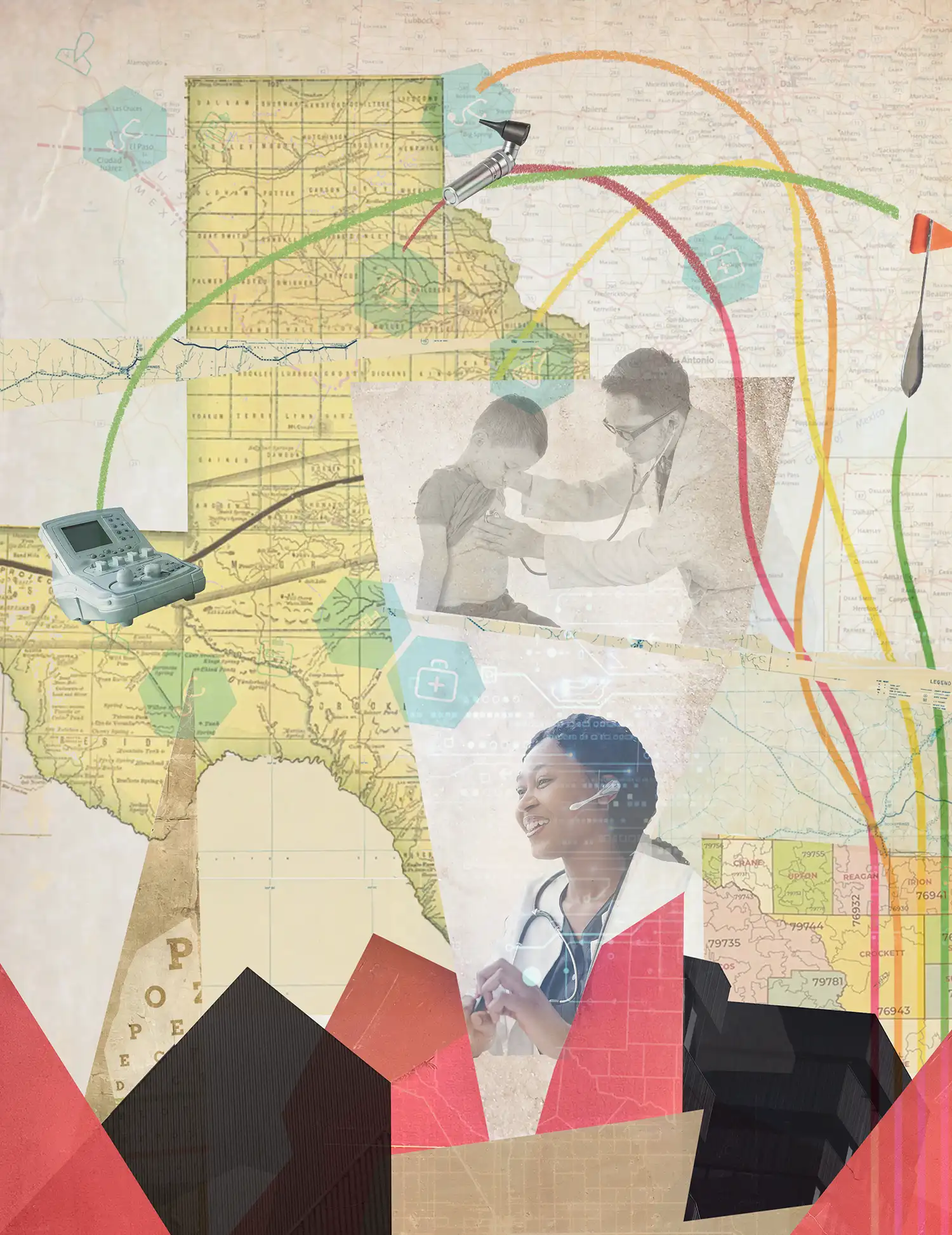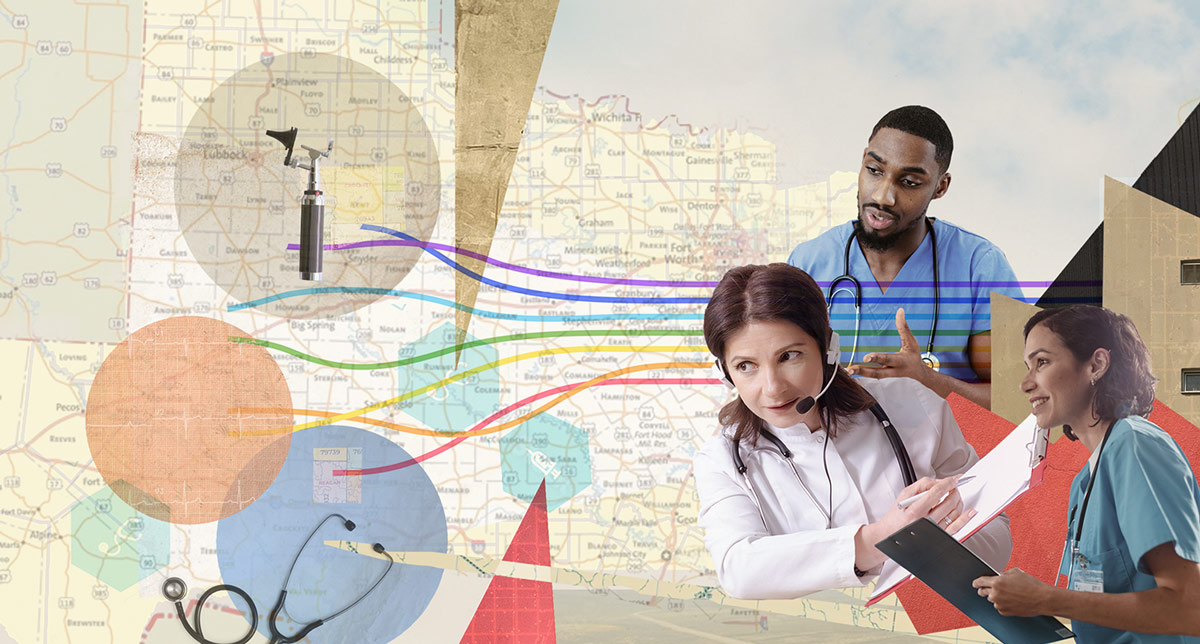Taking Care to the People



hroughout Texas, there are many small pockets of rural areas with residents who have little, if any, access to health care. But, with advances in technology, it is possible to take some aspects of health care to them.
The university administration made this case to lawmakers in 2023 during the 88th Texas Legislative Session. Their successful pitch earned TTUHSC $10 million in funding to provide more accessible health care for its 121-county service area. That money led to the creation of the Institute of Telehealth and Digital Innovation (ITDI), which supports five projects to make access to care a reality for millions of Texans.
Telepsychiatry Initiative:
Collaboration With TORCH to Provide 24/7 Access to Psychiatry Services
The first, less than an hour after the implementation of the Telepsychiatry Initiative, a psychiatrist treated a pediatric patient, which led to a prompt discharge from the hospital. The second, another patient who had been at Titus for more than 70 days, was discharged only four days after implementation of the Telepsychiatry Initiative.
“I couldn’t have written a better script,” Scoggin says.
The Telepsychiatry Initiative, is led by Cynthia Jumper, MD, MPH, executive vice president for Health Policy and Strategic Initiatives and Will Rodriguez, associate vice president and Managed Care administrative officer. It aims to significantly advance mental health services for patients in rural community hospital emergency departments across Texas by providing access to a psychiatrist. There are 12 sites currently involved, with another seven in the process of joining. Since May 2024, there were 175 facilitated telepsychiatry visits.
Titus is part of the Texas Organization of Rural and Community Hospitals (TORCH), a nonprofit that addresses the needs of rural community hospitals. Through the initiative, contracted psychiatrists are available online to the emergency department staff, helping patients who go to the Titus emergency room in a psychotic episode. The assistance is especially helpful for Titus County, which has only one psychiatrist for the county’s more than 31,000 residents.
This has been an issue Kathy Griffis, MBA, BSN, RN, Titus’ chief nursing officer, has worked to address. Now, patients are appropriately treated by a mental health provider and, in most cases, released within hours, with follow-up care. Before, any patient suffering a psychotic episode would stay in the emergency room, leading to overcrowding – an issue that got so bad there were times when psychotic patients couldn’t get a bed for weeks. That wait time also led to more intense agitation, which often led to workplace violence.
“It’s a double-edged sword; they need our help, and our staff needs to be safe. What could we do to help them?” Griffis asks. “It really felt like we stopped that acute psychosis.”
“The most important thing is the patient gets the help early. So, they get seen early, and they get treated early,” Griffis says.
Campus Health Connect:
Establishing Telehealth Facilities in Schools
Physicians like Timothy Benton, MD, (Medicine ’94) use what he calls an ABCD model: asset-based community development. That is why he thought public schools and school nurses (the assets) could provide a path to partner with TTUHSC (community development).
That led to his work helping establish the Campus Health Connect through TTUHSC Odessa.
“That’s an asset in the community, right? And there’s already a health care provider in the school. So, let’s build off that,” Benton, regional dean and professor in the School of Medicine, says.
The goal is to establish telehealth sites in rural school districts throughout the Permian Basin, providing a hand-held camera device, a virtual stethoscope and other computer equipment used in telehealth visits. The setup would primarily benefit school children with chronic illnesses like diabetes or asthma. It could also help those who need treatment for a cold or other acute diseases. That way, parents and patients would not have to drive — half an hour or more — to the nearest health care facility. For $20 per visit, students and parents can engage with a telemedicine provider.
“In the end, we’ll meet the three pillars of the university mission: delivering patient care, being educational and offering us an opportunity for research,” Benton says.
The School of Medicine already has residents embedded in rural community hospitals. By adding this program, Benton says, there is an opportunity to create an even larger health care delivery system.
“What telehealth does is multiplies (that system), potentially right where we can go into places that we couldn’t necessarily put a physical asset,” Benton adds.

Access to Breast Health for Texans:
Taking Breast Exam Technology to Rural Residents
When Tadie Nowlin, a teacher and resident in Roscoe, Texas, found out she could have a free breast exam for early cancer detection, she thought it was an opportunity she could not pass up.
“I just came across the street,” Nowlin says. “I didn’t have to take off work or drive to Abilene (Texas), an hour away.”
Her screening was conducted through a collaboration between the TTUHSC Laura W. Bush Institute for Women’s Health (LWB) and the Bexa ™ Equity Alliance. The early detection and education program offers free breast exams to women of all ages in 24 rural counties surrounding Abilene. The initiative is led by Connie Tyne, executive director, and Pearl Merritt, EdD, MSN, senior director of community outreach, at the LWB. There is no radiation, and results are available quickly — about 48 hours if an abnormality is detected or immediately if no issues are found.
Bexa Breast Exams™, a painless process using two technologies cleared by the U.S. Food and Drug Administration, is performed by highly trained, registered breast sonographers and designed to detect potentially harmful masses in breasts.
“Mammograms are great; that’s how my breast cancer was found,” Tamara Alexander, LWB’s Bexa ™ project manager, says. “I think this is an easier process — no radiation, no squeezing, no pinching, and you get immediate results when you leave.”
Since the collaboration began in November 2024, more than 450 women have received exams. Less than half were women older than 50. An analysis after the examinations also revealed that 60% of women in rural areas had never had a mammogram.
Alexander noticed a marked interest in the program among younger women. A study released in December by the Radiological Society of North America also notes that breast cancer rates in women younger than 40 increased significantly throughout the U.S. between 2001 and 2021 . These younger women also account for nearly 35% of the women who received the Bexa Breast Exams.
“I think if this technology had been available for me, I would have jumped on it,” Alexander says.
Telehealth infrastructure expansion:
Helping to Manage Chronic Conditions at Home
Through TTP, certain patients who suffer from chronic conditions are given at-home health equipment, Remote Patient Monitoring, which is monitored by registered nurses. John C. DeToledo, MD, School of Medicine dean and executive vice president for Clinic Affairs helps lead the project with Clay, associate vice president for Clinical Practice.
Those with chronic conditions are chosen because there is more of a chance of getting ahead of any long-term complications. Staffers can check in with the patient if they notice anything concerning and suggest that person see a doctor soon or educate the patient on ways they can help themselves.
“Now one of the people monitoring those devices says, ‘Hey, just checking in, what’s going on?’” Clay says. “And they’ll have a conversation about this is what you need to do next.”
Through ITDI support, the Remote Patient Monitoring program onboarded a program manager, a registered nurse and a licensed vocational nurse.
Healthy West Texas Initiative:
Surveying West Texans to Identify Health Issues
This community-based pilot project tests new data collection methods to improve health outcomes. It is led by Deborah L. Birx, MD; Ron Cook, DO; Billy U. Philips Jr., PhD, MPH; Gerard Carrino, PhD, MPH; and Irum Zaidi, MPH.
This summer, a team of TTUHSC staffers conducted a house-to-house survey in Crane, Texas —about 30 miles south of Odessa, Texas— to assess individual health status through testing for diabetes, hypertension and obesity. The team surveyed nearly 20% of Crane’s adult population, revealing 22% of respondents reported limited access to health care in the past year, 50% meet the obesity definition and 38% were in either Stage 2 or 3 hypertension. Nearly all were unaware of their early-onset health issues and those who were aware expressed challenges accessing care, Zaidi says.
The next step focuses on client-centered services, helping individuals to take greater control over their health, including through the use of digital tools and real-time health data. “This is about empowering individuals and communities with the information they need to thrive,” Zaidi says.